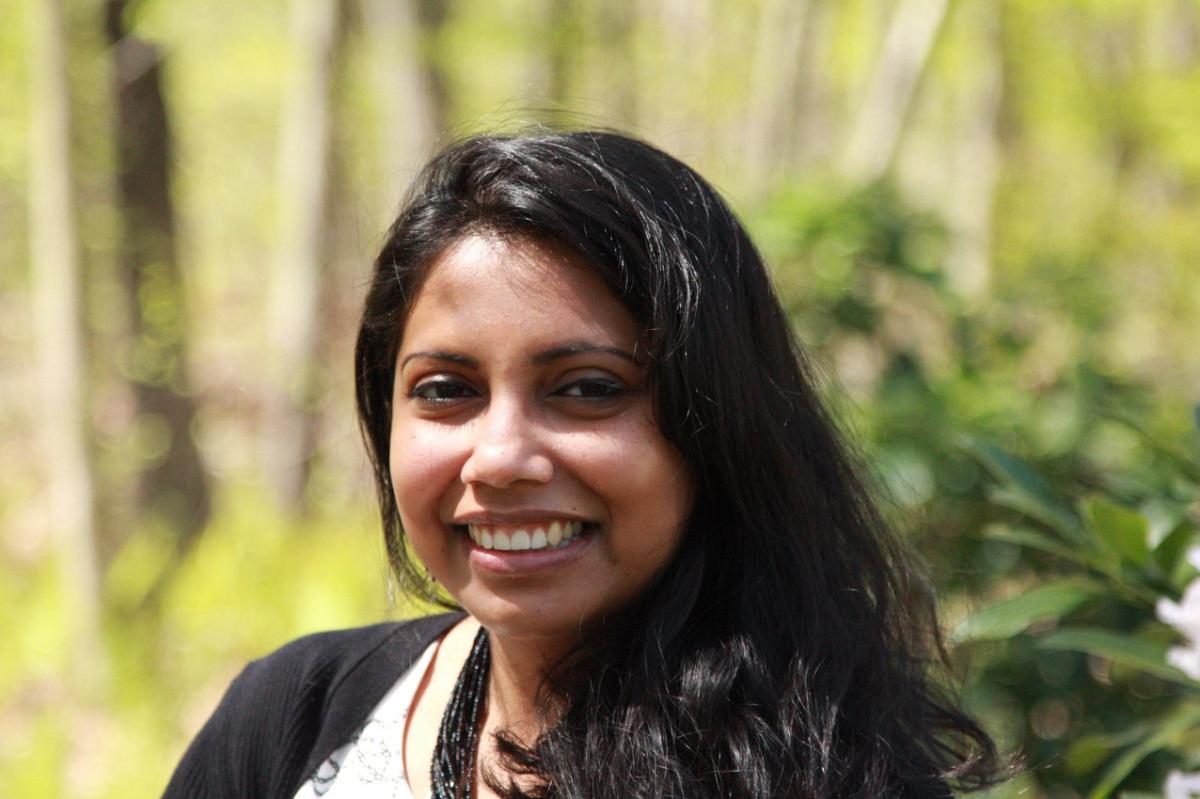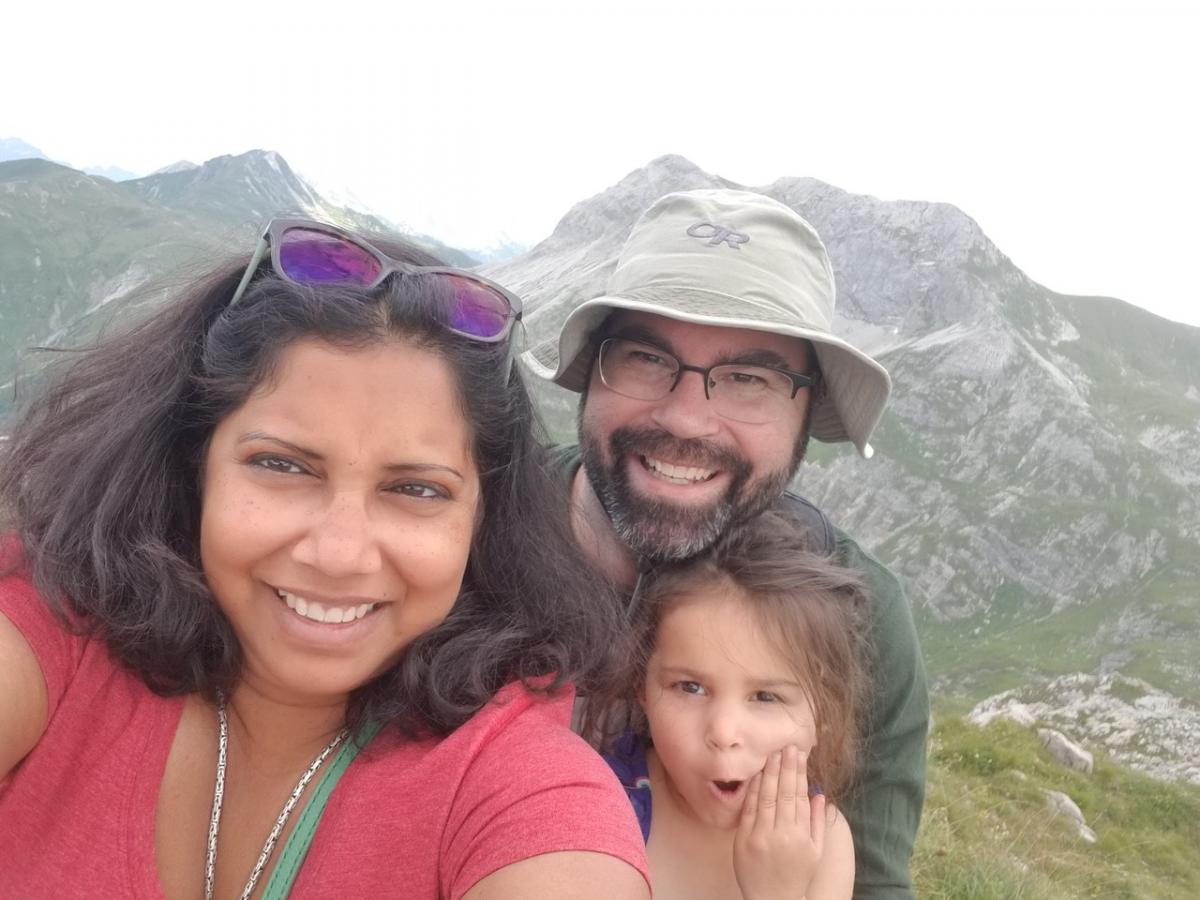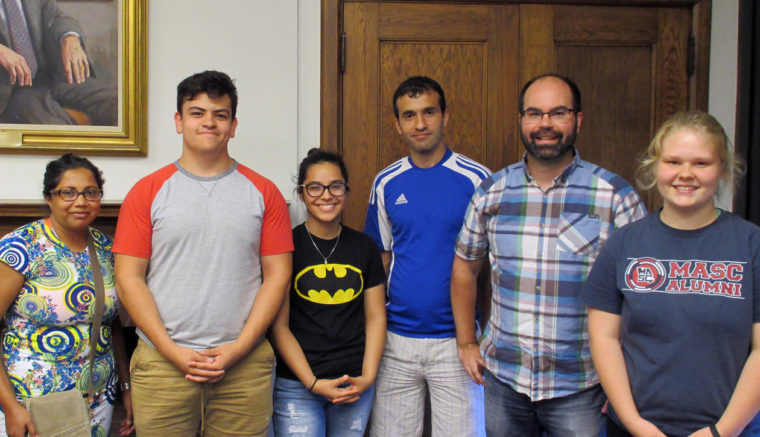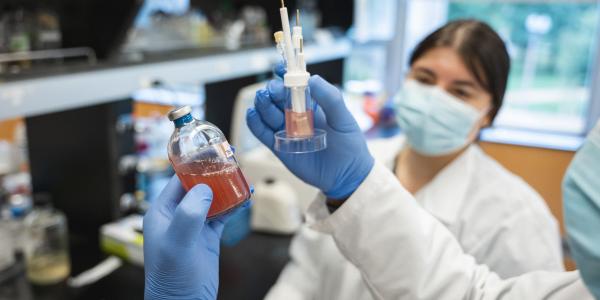In this Q&A, microbiologist Arpita Bose discusses her solutions-oriented approach to big problems from climate change to diversity in STEM.

For microbiologist Arpita Bose, science is a necessarily interdisciplinary and collaborative endeavor. Bose, who will be promoted July 1 to associate professor in the Department of Biology in Arts & Sciences, describes herself as a “glass half full,” “solutions-oriented” person. She has a keen instinct for finding creative approaches to even the thorniest questions.
Bose’s lab focuses on microbial metabolisms, taking an interdisciplinary approach to address issues related to energy and sustainability. Bose has published research on how microbes can “eat” electricity, using a novel process to harvest electrons straight from an electrode source. By locking away carbon dioxide, these electricity-loving microbes may potentially play a role in combating climate change.
Bose was recently named an associate editor of the journal Applied and Environmental Microbiology, where she hopes to improve transparency, diversity, inclusivity, and fairness in peer-reviewed scientific publishing, especially for early career scientists. She was also chosen to be a faculty marshal in this year’s graduate school commencement ceremony in recognition of her dedication to mentoring students at all levels, and her work in finding pipelines to attract women and students of color into STEM fields.
In this Q&A, Bose reflects on her journey from student to associate professor and the lessons she’s learned along the way. She also looks to the future of science as a profession and the small changes happening now that she thinks will add up to a big difference on a global scale.
Collaboration has been a hallmark of your work at WashU. What drives your interest in collaborative research?

Collaboration was a natural choice for me, even before I came to WashU. When I was in grad school, there was this drive to have a singular focus, to do the work I would publish by myself or just with my mentor. But around the time I was finishing graduate school, my mentor gave me some good advice. He said, in the next phase of your career, now that you’ve established yourself as someone who can do all these different things, it’s time to collaborate openly and do extraordinary science that you alone may not have the bandwidth or even the skill set to do. When I started my postdoc, the collaboration happened naturally because I was coming into that experience with an open mind, ready to approach projects in a different way. Conversations led to projects, and projects led to grants. I’m a very social person, so that model was a perfect fit for me.
At WashU, I kept that collaborative spirit. I knew that to do climate science – which is what I’m especially interested in – and do it well, I’d need collaborators from across disciplines. Most people think of microorganisms as nasty microbes that cause disease, but I’m more of a glass half full sort of person. Microorganisms are everywhere, doing really positive things for us, including carbon cycling and other geochemical cycling. As a microbiologist, I study microbes in the lab. Maybe sometimes I go out and collect samples in the field to study. But, at the end of the day, I have to depend on the expertise of scientists across fields, from Earth and planetary sciences to engineering. I’m just one tiny piece of the puzzle, but I’m motivated by seeing the whole scientific community come together to work on solutions.
What collaborations are you particularly excited about right now?
At WashU, Mark Meacham in the McKelvey School of Engineering and I recently received funding from the U.S. Department of Defense to study electron uptake in bacteria. I’m really excited about that project and the opportunity to develop new tools in a truly interdisciplinary way. I have also established collaborations with David Fike in Earth and planetary sciences and Bob Kranz in biology.
I’m also currently establishing collaborations with researchers in different countries, who reached out to me after I published research on bioplastics in 2019. Scientists in the European Union have been very interested in working with my group on projects in sustainability, especially efforts to sustainably produce different kinds of bio-commodities, including bioplastics and biofuels. I’m also starting to have collaborations outside the EU, in Asia and India, for instance, so stay tuned! It’s been energizing to join an international community of scientists who appreciate that climate action must be a global collaboration – it isn’t going to be solved in one day or by one individual or even one country.
Reflecting on your first six years at WashU, what experience has most impacted your career or your approach to science?

The one thing I was unprepared for was to be a mother. Earlier in my career, when my partner and I were both postdocs, we just couldn’t afford decent childcare and an apartment in Boston. Even after coming to WashU, deciding to have a child was still a very difficult thing for me because there’s so little support in the U.S. for working mothers. I naively thought that everything would work itself out as we went along, but I made all these massive mistakes.
For example, when I was pregnant, I didn’t sign up for childcare, and the waiting lists were so long that I didn’t have childcare for the first six months of my daughter’s life. I was freaking out, trying to start my lab while dealing with the complete chaos of taking care of a baby. Luckily, my family and my husband’s family were able to come help us. Since then, I’ve reached a point where I’m caring for both a child and my aging parents, and managing a lab seems seriously much easier than both of those things, but it was a steep learning curve.
Do you think this issue is unique to women in STEM? Do you see solutions on the horizon?
It’s not just women. I think my husband was equally affected. And it isn’t just academics. We all have colleagues who have children, figure out how to manage competing personal and professional obligations, and then they move on and the conversation ends. Moving forward, I hope we can better support young scientists and professionals who find themselves in the position of having to navigate dependent care issues. I’m glad to see this conversation continuing after COVID, and I’m hopeful that policy changes at the highest levels of government will improve things. Just think how much farther we could have been in climate action if scientists didn’t lose a substantial period of their lives when their kids are really little! In all seriousness, though, I do think we would be less stressed and more productive if we had good policies in place.
What other types of actions or support do you think would help scientists from all backgrounds thrive?
I don’t get many women applying to join my lab, so I’ve started thinking about how I can change that and increase other kinds of diversity by empowering future scientists. It’s not enough to work on recruiting at the postdoc or graduate level, though providing strong mentorship is also incredibly important at that level. Improving diversity starts way before the undergraduate degree, ideally at the middle or even elementary school level. Students that young can do anything they want, and they need opportunities to learn and be heard. When I moved to St. Louis, I realized that this is a complex community with a lot of opportunities to hear different voices, and sometimes these voices are completely unheard, even locally. I’m a very solutions-oriented person, and I knew that at least locally I could make a difference.

In 2017, I started working with a local high school to bring student interns into several labs in biology during the summer. Having minors come work on campus is complicated, but it’s something I feel really strongly about doing. Ultimately, I do think that, if we want to solve the world’s problems, we need to have thousands, millions, zillions of voices and ideas. No one person can do this alone, and I think some of the best solutions might come from the most unlikely places. Maybe from children.
Solving the world’s problems is a pretty big task! How do you keep from feeling overwhelmed?
When I see a problem, my first response is: What can I do to help? That approach helps me not get bogged down in just identifying problems. I’m here, and I know I can make a difference. Even if what I’m doing feels tiny and inconsequential against overwhelming problems, it’s got to start somewhere.
Growing up in India and learning about our independence movement taught me that an individual does matter. Your ideas are never too small; your effort is never too inconsequential. Don’t talk yourself out of taking action because you’re afraid or disheartened that your effort might be irrelevant. Movements start with individuals, then millions of people join in, all with their unique contributions. That’s why diversity is so important. Together we can change the world, but we need each other, our ideas, and our support to do so.




